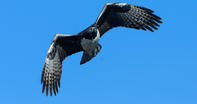
Name
Martial eagle (Polemaetus bellicosus)Appearance
The martial eagle is the largest of the African eagles. They are incredibly powerful and reputedly have enough power in one foot to break a man’s arm or knock an adult man off his feet.
This eagle weighs almost 6.5 kg, has a wingspan of up to 2.6 m and an average length of 85 cm. The upper-parts are dark brown and the belly white with black streaks. Martial eagles have white feathered legs and very large black talons. The immature birds are creamy-white with no black markings on the head.
Martial Eagle Diet
The martial eagle will eat whatever is available, with a preference for game-birds, hyrax, and poultry. In some areas birds form an important part of the diet, including guinea fowl, francolins and bustards.
Birds as large as a European stork are recorded to have fallen prey to the martial eagle. In other areas the diet is largely mammalian, especially hyrax and small antelopes.
Animals as large as an impala calf, monkeys and occasionally young domestic goats and lambs can be taken. Carnivores like mongoose, serval cat or jackal are sometimes taken and also snakes or large lizards. It is not known to eat carrion at all, except possibly dead lambs.
Martial Eagle Breeding
Martial eagles can breed during various months in the different parts of their range. The breeding season can thus begin in a wet season, the early dry season, or late in the dry season. Nests are always built in trees, at any height from 20 to 80 feet above ground.
This nest is often in the largest tree in the area, growing on a steep hillside or in a gorge, where the bird has a clear flight path from the nest. Martial eagle pairs have one or two nests which are used in alternate years if more than one but for successive breeding attempts if there is only one.
The nests are huge structures about four to six feet across and up to four feet thick and often basin-shaped when new - much broader than they are deep. They are made of large sticks and lined with green leaves. Incubation is normally by the female, but occasionally males have been known to incubate as well.
The female leaves the nest to feed and is not usually fed by the male. The incubation period is probably about 45 days. The chick is very weak and feeble when first hatched, but becomes more active after about twenty days. At 32 days feathers show through the down and completely cover the bird at 70 days.
The young is fed by both parents until about 60 days old when it starts to tear up the prey itself and is also well feathered. During the early fledging period the female remains near or on the nest and the male hunts and brings prey. After about 50 days she herself hunts or brings prey to the nest and the male seldom appears.
After making its first flight, at about 100 days, the fledgling may return to roost in the nest. It remains loosely attached to the nest site for some time and may be seen not far from it for up to six months.
Martial Eagle Behaviour
Martial eagles spend on average 85% of their time perched and take to the wing predominantly in the late morning at about 10am. They perch from around 3pm and this behaviour is largely driven by thermal availability. The martial eagle will soar with a full crop for hours on up-draughts without hunting.
They kill or attack by a long slanting swoop at great speed or a gentle descent into an opening in the bush. The speed of the descent is controlled by the angle at which the wings are held above the back. The martial eagle does most of its hunting aerially, soaring high in the air. The prey is surprised in the open by the speed of the eagle’s attack from a distance.
A pair of martial eagles may have a home range of anything up to 50 square miles and they wander about over most of it. They often hunt for several days in one area and then move on to another.
Although not migratory in the strict sense it makes local movements involving flights of several hundred miles and a pair may not usually be found near their breeding area. It is much shyer than the other big eagles of Africa and generally keeps away from man. It preys on game-birds and small animals but also upon man’s domestic animals.
 SouthAfrica.co.za provides informative, educational content on many South African bird species that orthologists and bird-watchers would enj...
SouthAfrica.co.za provides informative, educational content on many South African bird species that orthologists and bird-watchers would enj...